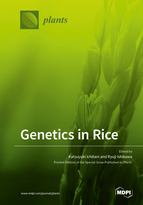Genetics in Rice
A special issue of Plants (ISSN 2223-7747).
Deadline for manuscript submissions: closed (31 December 2019) | Viewed by 52983
Special Issue Editors
Interests: reproductive barrier; disease resistance; varietal differentiation; genetics of agronomic trait
Special Issue Information
Dear Colleagues,
Rice feeds more than half of the world population. Its small genome size and ease in transformation have made rice the model crop in plant physiology and genetics. Molecular as well as Mendelian, forward as well as reverse genetics collaborate with each other to expand rice genetics. Syntety of rice with other grasses such as wheat, barley and maize has helped accelerate their genomic studies.
The wild relatives of rice belonging to the genus Oryza are distributed in Asia, Africa, Latin America and Oceania. Phenotypic and genetic diversity among them contributes to their adaptation to a wide range of environments. They are good sources for the study of domestication and adaptation.
Rice is the first crop whose whole genome was sequenced. With the help of the reference genome of Nipponbare and the advent of the next generation sequencer, study of the rice genome has been accelerated. Now 3000 (3K) cultivar genome information, the pangenome information comprising the whole genes among rice as a species, and the genomes of wild relatives of rice are available.
The mining of DNA polymorphism has permitted map-based cloning, QTL analysis, GWAS, and the production of many kinds of experimental lines such as recombinant inbred lines, backcross inbred lines, and chromosomal segment substitution lines. The genetics of agronomic traits and pest resistance has led to the breeding of elite rice cultivars.
Inter- and intraspecific hybridization among Oryza species has opened the door to various levels of reproductive barriers ranging from prezygotic—e.g., hybrid sterility, male sterility—to postzygotic—e.g., hybrid weakness, hybrid breakdown.
This Special Issue will welcome papers on genetic studies of rice and its relatives utilizing the rich genetic resources and/or rich genome information described above.
Prof. Katsuyuki Ichitani
Prof. Ryuji Ishikawa
Guest Editors
Manuscript Submission Information
Manuscripts should be submitted online at www.mdpi.com by registering and logging in to this website. Once you are registered, click here to go to the submission form. Manuscripts can be submitted until the deadline. All submissions that pass pre-check are peer-reviewed. Accepted papers will be published continuously in the journal (as soon as accepted) and will be listed together on the special issue website. Research articles, review articles as well as short communications are invited. For planned papers, a title and short abstract (about 100 words) can be sent to the Editorial Office for announcement on this website.
Submitted manuscripts should not have been published previously, nor be under consideration for publication elsewhere (except conference proceedings papers). All manuscripts are thoroughly refereed through a single-blind peer-review process. A guide for authors and other relevant information for submission of manuscripts is available on the Instructions for Authors page. Plants is an international peer-reviewed open access semimonthly journal published by MDPI.
Please visit the Instructions for Authors page before submitting a manuscript. The Article Processing Charge (APC) for publication in this open access journal is 2700 CHF (Swiss Francs). Submitted papers should be well formatted and use good English. Authors may use MDPI's English editing service prior to publication or during author revisions.
Keywords
- gene mapping
- genetic interaction
- varietal differentiation
- genomics
- genetic resources
Benefits of Publishing in a Special Issue
- Ease of navigation: Grouping papers by topic helps scholars navigate broad scope journals more efficiently.
- Greater discoverability: Special Issues support the reach and impact of scientific research. Articles in Special Issues are more discoverable and cited more frequently.
- Expansion of research network: Special Issues facilitate connections among authors, fostering scientific collaborations.
- External promotion: Articles in Special Issues are often promoted through the journal's social media, increasing their visibility.
- Reprint: MDPI Books provides the opportunity to republish successful Special Issues in book format, both online and in print.
Further information on MDPI's Special Issue policies can be found here.








